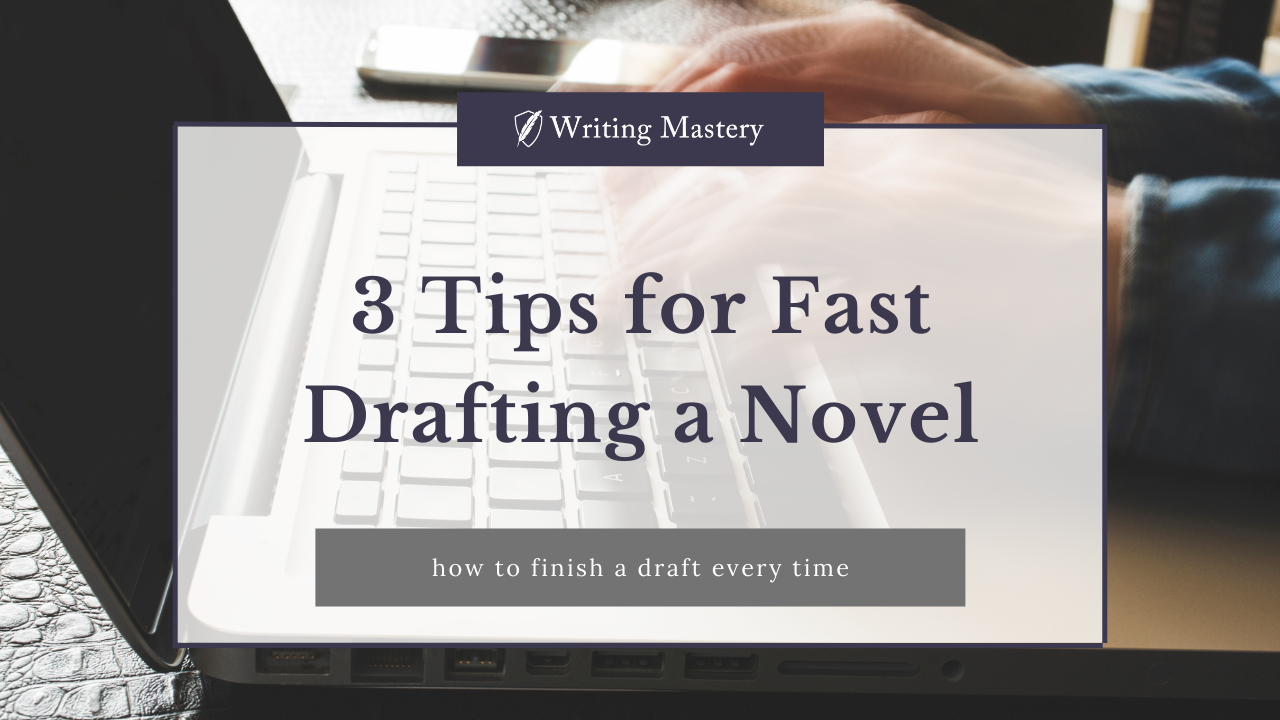3 Tips for Fast Drafting a Novel
Apr 21, 2022
Learning to fast draft a novel isn’t just about speeding up your writing process, giving yourself deadlines, or whipping out pages in record time. It’s also about teaching yourself how not to be one of those authors who eagerly starts a new and amazing project, then loses steam halfway through and never finishes.
Every writer has inevitably discovered that the sense of wonder that launched them into the book—the momentum, the spark, the inspiration—was not enough on its own to get them to the end.
Luckily, by arming yourself with these three simple but powerful techniques, you’ll have the proper mindset to not only propel yourself through the first draft of your novel, but to do it faster than ever before:
Banish the mindset of a perfect first draft
The first draft needs to exist before you can start fixing it. So here’s a mantra to remember when you’re tempted to go back and obsess over every word: Perfect is the opposite of done. If you look at perfection and completion as a binary—you can have one or the other, but not both—it’ll help you realize that the ‘perfect novel’ in your head will never be finished.
Instead of trying to write a perfect first draft, try writing a “discovery draft.” No matter how painstakingly you outline your book beforehand, there’s a process of exploration as you write that’ll never happen without discovering it firsthand. Scenes that sounded amazing in your head will have glaring plot holes when you reach them. A throwaway side character will pop up again and again. You’ll get to the end of a planned scene only to think of a twist that will change the direction of what comes next. You’re discovering this world and story for the first time, and only by reaching the end and looking back will you have the perspective to know what belongs and what doesn’t.
This is the importance of banishing the idea of a perfect first draft and embracing the mess of a discovery draft. Your mind needs the unfettered freedom to explore, rather than rigid expectations of perfection and comparison that will keep your book forever unfinished.
Sketch out your characters, plot, and world before you start
Some people are “plotters”—people who write meticulous outlines before starting—while others are “pantsers”—people who take that idea of a discovery draft to heart by figuring out their story as they go. Many writers fall between the two by having either an image of their main characters, a rough idea of their plot points, a vision of their setting, or a little bit of all three. Taking those basic concepts and diving just a little deeper into them before starting will work wonders in ensuring you don’t get stuck.
If you fall more on the “pantser” side and want to dive right in with only minimal planning, focus on the rule of fives. Think of five details about each of your main characters. Brainstorm five things that happen in the plot. Sketch out five aspects of your world or setting.
For writers who fall more on the “plotter” end of the spectrum, delving into some resources and methods beforehand can be beneficial. Think about external problems, deep-rooted flaws, and potential life lessons for your main characters, match up your book’s plot points to the in-depth story beats of Save the Cat! Writes a Novel, or plan how the high-level details of your world, such as politics or economy, affect your main character.
If you’re not sure whether you fall more on the “pantser” or the “plotter” end of the spectrum, just start with the most basic preparation for each, decide how much deeper you want to go in each area, and feel free to call it enough when you’re ready to move on. Preliminary planning can help keep you on track, but ultimately, you know yourself and your methods best. Whatever gets the novel written is what matters most.
Practice persistent forward momentum and invisible revisions
These two techniques are invaluable for plowing through that first draft in record time. Persistent forward momentum means you should always be moving forward through your novel, never backward. As we said earlier, this first draft is a process of discovery. But too many writers go back and edit or rewrite what they just discovered rather than continuing forward and discovering more.
These writers often get trapped in an endless cycle of rewriting and second-guessing and fail to make any progress. The idea of persistent forward momentum is to embrace the mess of your first draft by getting through it as fast as possible and worry about cleaning up that mess later—once you have a much better idea of where your story will take you.
Invisible revisions are another important tool. Here’s how they work: Even though you, the writer, know full well you won’t look back as you draft and that you’ll save all your big revising and rewriting for your second draft, your mind is already tossing out ideas. If my character had a medical background instead of a legal one, you think, saving this side character would be more believable. It’s great that your mind is already working on this! But going back and making every change the second you think of it sets you back from finishing, and not just because of the time taken for that particular edit.
For example, you may make the change only to realize shortly afterward that it needs to change in some other way. Or you don’t like the change and decide to change it back. Or the change causes cascading changes you didn’t anticipate.
Rather than get caught up in making changes as you think of them, write them down somewhere else—a notebook, a separate document, a note in your margins—and continue writing forward. However, pretend that you did make the revision and continue the book as if the change is already there.
Suddenly, in our example, your main character went to medical school instead of law school. The revision exists in your mind and notes, but it does not exist in the earlier section of the first draft itself. This lets you see whether you like the change before catching the whole draft up, and continue writing forward rather than getting caught up in rewrites.
As you might imagine, this makes for quite a messy first draft, but that first draft is for your eyes only. By keeping track of your revisions on the side and implementing them “invisibly,” you’ll finish with a strong idea of whether they’ll be the right changes to make when you head into your second draft.
With these three techniques, you’re already well on your way to finishing your novel in record time. If you want the complete step-by-step action plan to finish every project you start, head to the full Novel Fast Drafting course!
As long as you remember to embrace the mess of your first draft, do some preliminary planning, and plunge forward through your novel without looking back, you’ll have a finished piece of art on your hands before you know it—something beautiful and malleable and one hundred percent your own.





